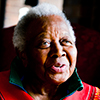



Stockwell, a 31-year-old Texas native and Columbia College grad, has spent the last two years laboring over his film Burnt in Memory, My Lover Has Steel Legs and Street Lights for Eyes, a simple portrait of Chicago with a fully improvised soundtrack featuring notable local musicians such as Azita Youssefi, Whitney Johnson of Verma and Matchess, and Bloodiest members Ben Clarke and Nandini Khaund. Burnt in Memory is slated for a January 2015 debut, and will be the centerpiece of an all-local film festival Stockwell is organizing at the Fine Arts Center to celebrate its release.
Interview by Luca Cimarusti
Photos by John Sturdy

I finished college here, and I got a job, and unlike everyone else who moved to New York and LA, I kept working, and now I’m still here. [I chose Chicago because] I’m from Texas, and it’s not Texas. [Laughs]
I came to Chicago because it has a great film community and I wanted to be a part of something that would teach me, and that I could grow from. And that’s the main thing. You come to the city to learn new things and experience new things, and to get your ass kicked.

I didn’t know much about the city before I moved here. Didn’t know anybody. I just came, sight unseen, and got a studio in Logan Square and made friends slowly.
I’ve been here ten years, so most of my adult life. This is home. I go visit Texas now, and I come back here and I’m like, “Ah, fucking buildings and people. I’m anonymous again.” Going from a smallish town to a big city, you get to disappear into the crowd.


I got superlucky when I was in college; I got an internship [at Outsider, a creative firm], and eventually they hired me. I became an assistant editor and I was, like, the worst assistant editor of all time. I came close to being fired a few times.
I always laugh at the time when I [realized that I] wanted to be a filmmaker. First off, I was in drama as a kid because three girls asked me to join because they needed more guys. But aside from that, my mom had these old Hitchcock films, and I had nothing else to watch, so I watched Dial M for Murder and it blew my mind. I’m like, “I wanna do that! I wanna know who does that.”

We shot skate videos and surf videos growing up. I know it’s weird being from Texas and shooting surf videos, which is mostly just, like, crumbly waves and a lot of static. I made a lot of mistakes, like editing in-camera with a VHS camcorder. The camera tricks in those were so lo-fi, like, they’d throw a dummy of a guy off the side of a cliff, and they cut to the guy standing up from falling—you know, just stupid camera tricks that I loved.
The original thing that I thought of [for Burnt in Memory] was that I wanted to shoot ten ten-minute shots of the lake. And I was like, “Well, why not just do the whole city?” I’d cover as much of the city as I could—go to the north side, go to the south side, go to the west side, go downtown. There wasn’t really a plan. I went down the rabbit hole and just followed whims, like, “Oh, this is happening today? I guess we’ll go over there.” Or “the Driehaus [Museum] is open,” which is this random old mansion. It’s interesting to go into a 19th-century millionaire’s home and see what it was like, basically untouched.

In the simplest form, Burnt in Memory is a portrait of the city of Chicago. A lot of people are doing portraits of this and that, but it is the non-travel-guide travel guide to Chicago. I wanted to show the city without any words and dialogue—a visual representation of the city, without a hypothesis, without a preconceived notion. It wasn’t like, “This is a crime-ridden city,” and cut to police lights. It’s not showing “Chicago’s a great place,” “Chicago’s a bad place.” It’s showing what I got with a camera at that time. I’m not trying to force anything. I was trying to remove myself [during shooting], then reinsert myself with the edit, joining ideas together to see what I found.
I shot 72 days in 2012, and it took over a year to finish editing it. It took forever.

I got harassed by cops only once. And it was because I was shooting next to a bank. It wasn’t even like it was anything sensitive. It was the weirdest police exchange I’ve ever had. They asked me what color flag I was. “Are you a black flag? Are you a red flag? Are you a blue flag?” I said, “Well, what does that mean?” He asked me, “Who do you identify with?” “I identify with people and society? I identify with hard-working people! Anyone who works hard.” It was the weirdest thing. It was before NATO, so I think it had something to do with that. I was wearing a yellow raincoat. I should have said I was a yellow flag.
Azita and Amber Walton-Amar, the pianist and cellist [on the Burnt in Memory score], fed off of each other really well. And a lot of these people had never met each other. So it was mainly just like, “Oh, let’s pick a key.” I know a little bit about music, but not enough to be like, “All right, let’s do this in F” or whatever. Ben Clarke, the musical director, helped translate a lot of that stuff. Sometimes they’d talk as they played. It was pretty loose. The first day, when there were 12 musicians, was the coolest time. They rehearsed, and people got used to the loose aspect, and had gotten comfortable with playing and messing up and not worrying about it. It was chaos, but it would land in the right spot at times and be great.
My girlfriend told me to watch Burnt in Memory high, so I did, and then I didn’t like it. And then I watched it sober and was like, “OK, this is good.” I got freaked out!






















